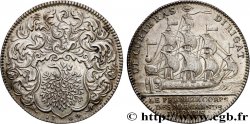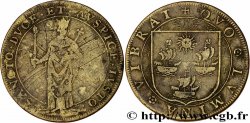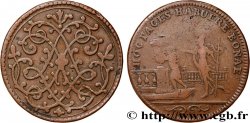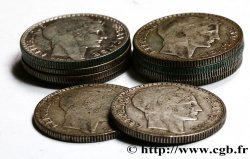fjt_128306 - CORPORATIONS - LES SIX CORPS DES MARCHANDS DE PARIS Les marchands bonnetiers 1746
non disponibile.
Articolo venduto sul nostro negozio
Prezzo : 200.00 €
Articolo venduto sul nostro negozio
Prezzo : 200.00 €
Tipo : Les marchands bonnetiers
Data: 1746
Metallo : argento
Diametro : 28 mm
Asse di coniazione : 6 h.
Peso : 6,99 g.
Grado di rarità : R2
N° nelle opere di riferimento :
Diritto
Titolatura diritto : LUD. XV. REX - CHRISTIANISS..
Descrittivo diritto : Buste à droite de Louis XV, signé FM, type Guéant Prieur 582H.
Traduzione diritto : Louis XV, roi très chrétien.
Rovescio
Titolatura rovescio : QUANTOS DUO FLECTIT IN USUS. ; À L'EXERGUE : LES MDS BONNETIERS. 1746.
Descrittivo rovescio : Écu aux armes des bonnetiers : cinq navires allant à gauche sous une étoile et au-dessous de la Toison d'or couronnée.
Traduzione rovescio : Vers combien d'usages il les tourne tous les deux.
Commento
En 1390, on comprend sous le titre de bonnetiers, les aumussiers, les mitainiers et les chapeliers. Dans les premiers temps de la fabrication appelée plus tard bonneterie, on appelait bonnet le fil de laine tissé à la main avec l'aiguille et la broche. Les bonnetiers ont le droit de vendre toutes sortes de bonnets de drap, de laine, ronds ou carrés, des bas, gants, chaussons, camisoles, caleçons, au métier, au tricot ou à l'aiguille, en soie, laine, coton, chanvre ou lin, poil de chameau ou de castor et autres pareilles matières.
Les bonnetiers étaient chargés de tisser à la main le fil de laine avec une aiguille, la bonneterie, ou à l’aide d’une broche, pour le broché ou “jersey”. On les appelait aussi chapeliers, gantiers ou mitainiers mais avec le temps le terme bonnetier devient générique. Leurs statuts sont rédigés en 1550 et confirmés en 1608. En 1660, un arrêt décide qu’ils auront préséance sur les orfèvres et seront désormais au cinquième rang des marchands, ce que rappelle les cinq navires sur leur blason ou au revers de ce jeton. En 1776, unis aux chapeliers et pelletiers ils formeront le troisième des six corps. Au XVIIIe siècle il y a environ 450 maisons de bonneterie à Paris. La devise du revers est strictement liée à la corporation des bonnetiers (F. 4872-4880b).
In 1390, the title of hosier included the almussiers, the mitteners and the hatters.. In the early days of the manufacture later called hosiery, the woolen thread woven by hand with a needle and spindle was called a bonnet.. Hosiery makers have the right to sell all kinds of cloth or woolen caps, round or square, stockings, gloves, slippers, camisoles, underpants, loomed, knitted or needle-knitted, in silk, wool, cotton, hemp or linen, camel or beaver hair and other similar materials..
Hosiery makers were responsible for weaving wool yarn by hand with a needle, hosiery, or using a spindle, for brocade or “jersey”. They were also called hatters, glovers or mitteners but over time the term hosier became generic.. Their statutes were drawn up in 1550 and confirmed in 1608. In 1660, a decree decided that they would have precedence over the goldsmiths and would henceforth be in the fifth rank of merchants, as recalled by the five ships on their coat of arms or on the reverse of this token.. In 1776, united with the hatters and furriers, they formed the third of the six corps. In the 18th century there were around 450 hosiery houses in Paris.. The motto on the reverse is strictly linked to the hosiery guild (F. 4872-4880b)
Les bonnetiers étaient chargés de tisser à la main le fil de laine avec une aiguille, la bonneterie, ou à l’aide d’une broche, pour le broché ou “jersey”. On les appelait aussi chapeliers, gantiers ou mitainiers mais avec le temps le terme bonnetier devient générique. Leurs statuts sont rédigés en 1550 et confirmés en 1608. En 1660, un arrêt décide qu’ils auront préséance sur les orfèvres et seront désormais au cinquième rang des marchands, ce que rappelle les cinq navires sur leur blason ou au revers de ce jeton. En 1776, unis aux chapeliers et pelletiers ils formeront le troisième des six corps. Au XVIIIe siècle il y a environ 450 maisons de bonneterie à Paris. La devise du revers est strictement liée à la corporation des bonnetiers (F. 4872-4880b).
In 1390, the title of hosier included the almussiers, the mitteners and the hatters.. In the early days of the manufacture later called hosiery, the woolen thread woven by hand with a needle and spindle was called a bonnet.. Hosiery makers have the right to sell all kinds of cloth or woolen caps, round or square, stockings, gloves, slippers, camisoles, underpants, loomed, knitted or needle-knitted, in silk, wool, cotton, hemp or linen, camel or beaver hair and other similar materials..
Hosiery makers were responsible for weaving wool yarn by hand with a needle, hosiery, or using a spindle, for brocade or “jersey”. They were also called hatters, glovers or mitteners but over time the term hosier became generic.. Their statutes were drawn up in 1550 and confirmed in 1608. In 1660, a decree decided that they would have precedence over the goldsmiths and would henceforth be in the fifth rank of merchants, as recalled by the five ships on their coat of arms or on the reverse of this token.. In 1776, united with the hatters and furriers, they formed the third of the six corps. In the 18th century there were around 450 hosiery houses in Paris.. The motto on the reverse is strictly linked to the hosiery guild (F. 4872-4880b)








 Segnalare un errore
Segnalare un errore Stampate la pagina
Stampate la pagina Condividi mia selezione
Condividi mia selezione Fai una domanda
Fai una domanda Consegnare / vendere
Consegnare / vendere
 Descrittivo
Descrittivo










